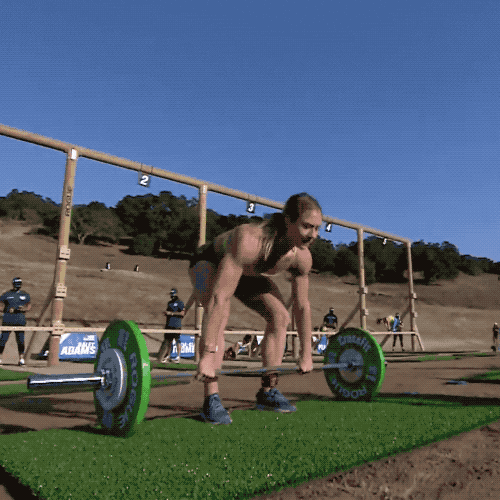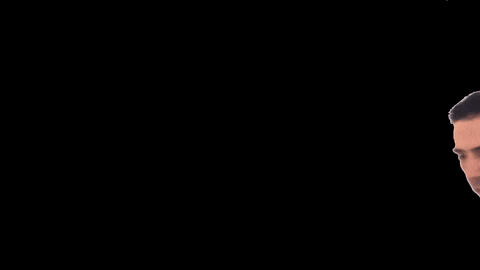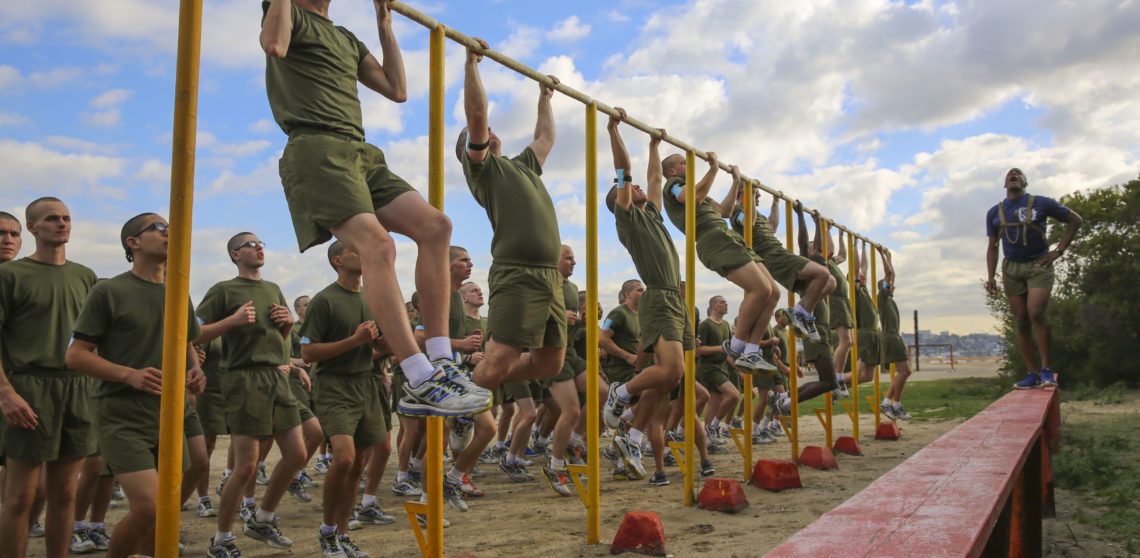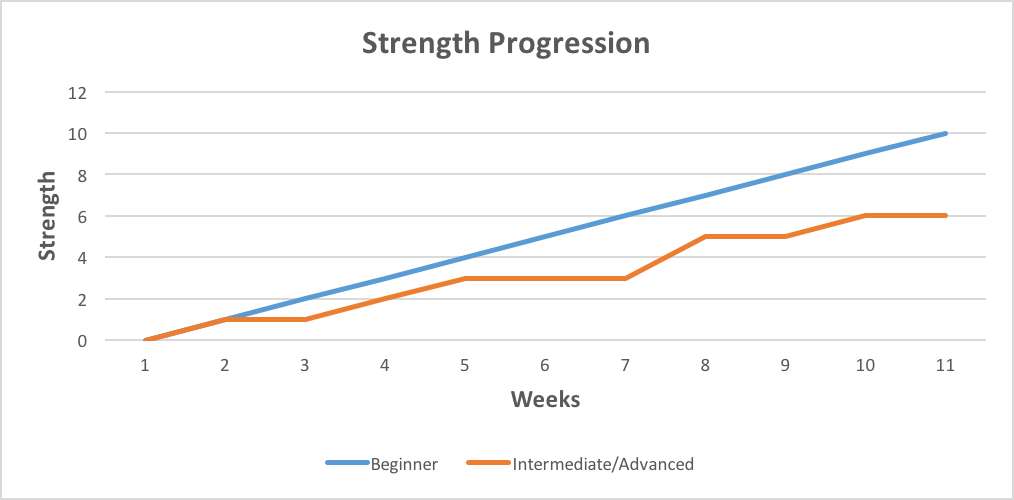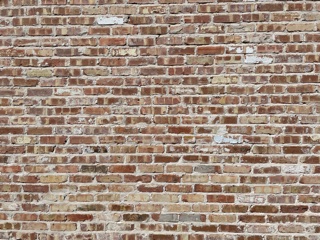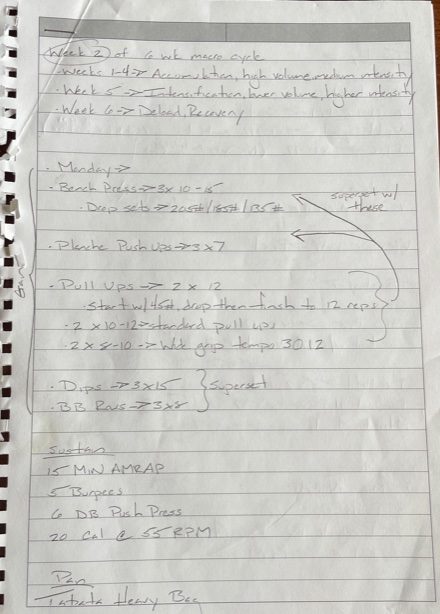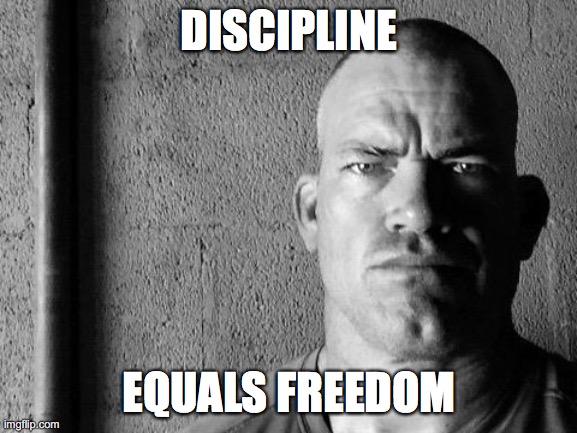If it’s so easy to get in the habit of scrolling through Facebook, why can’t it be just as easy to make exercise a habit?
Why is it such a life-long struggle for most people to develop and stick to some form of consistent exercise/movement program?
As humans, didn’t we evolve to move around all day? We descend from hunter-gatherers who literally had to spend their days running around hunting wild prey, walking miles to gather food and water, ALL WHILE TRYING NOT TO GET KILLED BY WILD ANIMALS!

With this lineage, shouldn’t a desire to exercise just be in our blood?
Well, it turns out we also evolved to value rest. All that hunting and gathering while trying not to get killed required a lot of energy. So when the time came to hunt that bison or run from that lion, we had to make sure we had the energy to do so. Otherwise it was game over!
So saving energy, aka rest, became stamped in our DNA as well. The only difference now is that we aren’t really storing up that energy for any life-saving activities. If we get hungry we don’t have to chase down a bison while avoiding getting eaten by a tiger. We just have to walk to the fridge or swing through a drive-thru.
No work needed and no danger to avoid. Fantastic for us! But on the flip side, no calories burned either like our hunter-gatherer ancestors.
We’ve essentially saved up a bunch of calories for nothing!
So don’t be so hard on yourself. Turns out we are hard wired to be lazy…I mean rest.
But even if we understand our hard wiring a little better, the question still remains, why is it so hard to form GOOD habits?
Habits form no matter what. It’s just that without thought or intention, the ones that form are usually bad.
Drinking too much alcohol, watching too much television, scrolling through our phones too much or eating too much junk food. For many, these are habits.
We don’t generally set out to form these bad habits. Rather, we live our lives and look up at some point and realize we have formed a litany of bad habits.
I know it’s happened to me. Phones are addicting. I know this. Everyone knows this at this point. I also know that staring at a little screen all the time is not good for my health. Mental or physical health.
Yet even knowing this, I get these weekly updates telling me how much time I spent on my phone the previous week and they always leave me astonished.
“I spent over five hours per day last week on my phone?!?!”
Just like that, without even consciously thinking about it, I’ve formed a bad habit of picking up my phone and scrolling through it any time I get bored.
Why are good habits so HARD to form but bad habits are so EASY?
Bad habits seem to form unconsciously while good habits only seem to form consciously.
Bad habits are easy to form. Good habits are hard to form.
But why?
Why can’t we ever fall ass-backwards into some great habit like we do with bad ones?
For me, it’s a matter of delayed vs. instant gratification. I’d imagine it’s the same for others as well.
BAD HABITS = INSTANT GRATIFICATION
Eating a box of donuts feels good immediately. Scrolling through social media feels good in the moment.
GOOD HABITS = DELAYED GRATIFICATION

Working out feels hard in the moment. But afterwards you feel great. Eating healthy is often challenging in the moment. It requires planning and more work than pulling through a McDonald’s drive thru. But afterwards you feel strong and energetic which is in stark contrast to how we usually feel after a Big Mac, fries, and a soda.
And the truly great gratification from working out; more muscle, abs, better health markers, etc., is really delayed. These benefits take months, sometimes years, to show up.
Bad habits feel good now. Good habits feel good later. One thing to add though is that while bad habits feel good now, they often make you feel bad later.
Donuts are good now. Donuts over time, year after year, not so good.
None of this means that forming good habits is impossible. Doing so just requires more forethought and intention than forming bad habits.
Motivation vs. Habits
Motivation can get you started along a path, but it’s habits that keep you going down the path.
It seems nowadays many people bash motivation. Like it’s a complete waste. “It doesn’t get you where you need to go.” “It doesn’t last.” I get where they are coming from, but I don’t see motivation as totally worthless.
I love some good motivation. Watching a Jocko Willink clip or a David Goggins post gets me fired up. I love it!
I also understand that motivation has its place. It ALWAYS fades and cannot be counted on to be the driving factor in any large positive change. Only habits can drive that.
The New Year is a prime example of this. There’s no time of year where motivation runs as high. We are fired up to make positive changes. “This year is going to be the year,” we tell ourselves. I love this! I think this kind of positive thinking is great. But it doesn’t last.

The motivation to work out that we have at the beginning of the year is not going to be there seven months later when it’s the middle of August, it’s 100 degrees outside, and you’re finishing up a crappy day at work and feel exhausted and just want to go home and flop down on the couch.
Whether or not you workout that day won’t be due to motivation. It’ll depend on whether or not working out is a habit you’ve formed prior to that moment.
If it’s a habit then you’ll work out even though New Year’s is a long-ago afterthought, it’s hot as hell outside, you just finished up with a long day of work, and you’re feeling exhausted. If it’s not, then you probably won’t.
That’s the power that habits can have. So why not use that power in our favor?
Let’s leverage the power of habits.
My History with Exercise
I started lifting weights when I was 14 years old. I’ll never forget a buddy of mine who I hadn’t seen in months stopped by my house. He had started lifting weights and showed me his guns and I was literally amazed. I couldn’t believe he had been able to make that physical change in his body.
I immediately got a membership to his gym and started learning from him and the rest was history. Well, it wasn’t that easy. It became a habit and that is how it became history.
But even saying, “and that is how it became history” is over-simplifying things. The truth is that it took many years for it to be as consistent as it is today. Initially I would work out for months but then life would get in the way and I’d skip a few days here and there and next thing you’d know a few months would pass.
But over time I learned to fight through the resistance, the procrastination, and the slate of external circumstances life threw at me and eventually exercise became a habit that I do day after day, week after week, year after year.
Whenever I run into people I haven’t seen in years they’ll always ask me, “are you still working out?” They are always amazed when I say yes. They act like I have some iron will power.
I assure you I do not!
There are many areas of my life where I haven’t formed the right habits. It’s just that for some reason or another exercise is an area where I did make it a habit.
I don’t really think about it every day. I don’t wake up dreading having to workout later on. I just kind of do it. Just like I just brush my teeth without thinking about it. It’s just a habit and has become a part of who I am.

I need to take this lesson and apply it to other areas of my life. But for now, here’s how I managed to make exercise a habit.
While these are the steps I’ve taken, I’m sure they could work for you as well.
Steps to Make Exercise a Habit
1. Set Goals
I’ve always been a goal-oriented person. I mean, over the years I’ve probably sat down and made a thousand huge proclamations about how my life was going to change because I had written out some new goals.
But the majority of those goals faded away. Time passed and I never achieved them. On many of them, I never really even made much progress.
The reason is because when I made the goals, I never put much thought into how I was actually going to achieve them. I had no plan.
That wasn’t the goals fault. And it doesn’t mean goals are worthless either. They serve their purpose as long as the right actions are built around them.
The thing with goals is all they really do is provide direction. They are a starting point.
Just like motivation, they are a launching point.
Goals give direction. Habits get you to the destination.
Goals are the compass. Habits are the ship that takes you there.
For example, I set a goal for myself a few years back that I wanted to accomplish a one-minute, free-standing handstand. But if I had stopped there, I never would have accomplished the goal. I had to build some habits that would ultimately lead me to accomplishing that goal.


As Scott Adams, the creator of Dilbert wrote about, focus on the systems, not the goal. And systems are really just a series of habits.
To achieve my handstand goal, I created a system of habits that was two-fold.
First, I wrote handstand exercises into my workout routines.
Second, I did something that James Clear calls habit stacking. James defines habit stacking as, “one of the best ways to build a new habit is to identify a current habit you already do each day and then stack your new behavior on top.”
Here’s how I used habit stacking to help me get that one-minute handstand:
Even before the pandemic I often worked from home. When I’m working from home I drink a lot of coffee. I mean a LOT! With lots of coffee comes lots of morning trips to the restroom.
Drinking coffee and using the restroom were habits I already had. Wanting a one-minute handstand was a goal so practicing handstands was a habit I wanted.
So I stacked practicing my handstands onto my coffee drinking and subsequent restroom-break habits. Every time I got back from a restroom break while working in my office I did one max effort handstand. I simply propped myself up against the wall in a handstand position, kicked my feet off the wall until I was doing a free-standing handstand, and held it for as long as I could. Then I was back at my desk working.
While each handstand probably lasted a few seconds to maybe half a minute, over the years this has added up to hours of handstand practice.
The point of all that was to show that goals can have a purpose if planned properly. I set a goal to complete a one-minute freestanding handstand. I built systems to accomplish that goal. I eventually accomplished the goal.
But I do want to give a disclaimer on goals. It’s important to make them realistic. If they aren’t they can often have the opposite of their intended effect.
For example, let’s say someone made a goal to lose 20 pounds in a week (NOT realistic). After a week they ended up losing two pounds (realistic AND fantastic!). But because their goal was an unrealistic 20 pounds lost, this person may give up because they see their two pounds lost as a failure.
Of course losing two pounds in a week is not a failure! But with an unrealistic goal it could be felt that way by some folks.
In the end, remember, the goal is the compass. It provides you direction. Set ones that are clear, specific, and measurable. And just as important, make sure you set the processes around them so you know HOW you will ultimately achieve them.
2. Have awareness for all signs of progress
This step is tied somewhat into the setting of goals. But it’s been such a valuable tool for me in making exercise a habit over the years that I feel it’s important to talk about it separately.

One of the potential downsides of setting goals is that they can sometimes place blinders on us to all the signs of progress along the way to accomplishing the goal.
It’s often, “goal or bust!” Either I hit my goal or not.
As Ricky Bobby said, “if you ain’t first, you’re last.”
Talk about pressure! I like confidence and holding yourself accountable, but if your mentality is, “goal or bust” then the journey will be long, miserable, and often unsustainable.
Over the years, it became important for me to practice awareness along the way. As I worked to make exercise a habit I began to recognize and be aware of all the signs of progress.
Some of the signs of progress will tie directly to your goal. When I wanted to hit that one-minute handstand, I remember being pumped when I hit the 15, 30, and 45 second marks.
It took a LONG time to finally hit that one-minute mark. If I hadn’t recognized progress at the 15, 30, and 45-second marks I’m not sure I would have stuck it out to get to the end goal.
It’s also important to recognize all the other indicators of progress as you work towards your goals and making exercise a habit. Even if these indicators are not tied directly to your specific goal.
For example, for many folks they start exercising with a goal to gain more muscle or to lose a certain amount of weight.
But there are so many ancillary benefits to exercise as well. Like improved health markers (blood pressure, blood work, etc.), improved mood, improved sleep, more energy, etc.
Those ancillary benefits have PROFOUND positive impacts on your quality of life.
Recognize that connection between those benefits and your exercise goals. Recognize how your exercise goal may be having positive impacts you never imagined on your life. Be aware when you realize you’re starting to sleep better, or you suddenly have so much more energy throughout the day.
If you recognize ALL the signs of progress, it’ll help you keep the blinders off from your goal.
It’ll help you enjoy the journey.
It’ll help make the journey more sustainable which will help make exercise a habit.
I know it had that effect on me. When I started recognizing all the benefits exercise was having on my life, not just whether I was hitting whatever goal I had set or not, it made me that much more motivated to keep on doing it.
Keep those eyes open to all the signs of progress along the way. Have a sense of awareness so you are open to all those signs. Enjoy the journey.
3. Perfection is the enemy of progress
I remember when I first started working out, I had this idea that every single workout had to be perfect. I had to be “feeling it” and “in the zone” or it was a waste of time.
If I had an off day where I felt weak and was just going through the motions I’d feel like a failure that day.
That feeling often left me feeling de-motivated. It often led me to skip a few days and fall off the exercise wagon.
How counterintuitive is that? You’re too hard on yourself and ultimately sabotage your own ultimate goal?
Over the years I learned to remind myself that perfection is the enemy of progress.
Sometimes just getting to the gym is a win. Sometimes just “going through the motions” is enough. You don’t have to set a PR (personal record) every time you workout.
By learning to accept just okay days in the gym and to recognize that progress sometimes means just showing up, I learned to be much easier on myself which has been instrumental in me sticking to my exercise habit even on those days, and sometimes even weeks, when I’m just not really feeling it.
So take advantage of those days when you feel like you could run through a brick wall. But also remind yourself that showing up is a win on those days where you felt exhausted and the last thing you want to do is workout.
While just showing up may not make you fitter, it’ll definitely not make you less fit. And it will keep you from regressing, losing all those previously hard-earned gains.
In the end, if you’re progressing often, and not regressing on those down days, you’ll be on an upward trajectory.
Remember, progress, not perfection.
4. Don’t let one missed workout lead to one year of missed workouts
For the first few years that I started working out it seemed like it was a series of peaks and valleys. I’d go months being consistent and disciplined. But then, inevitably, I’d fall out of the routine for a few weeks, sometimes even months, and the cycle would perpetuate.

It was all or nothing it seemed. Feast or famine.
What I realized was happening was that I’d encounter some life event that would prevent me from working out for a few days or even sometimes a week. Maybe I’d get sick or when I was in school it might be a week of finals. But it seemed like some life event would always come up.
But that’s the thing with life events. Everyone has them and they never stop occurring. Things come up, we move on. But I didn’t move on.
For some reason, those few days off would lead to a few weeks off and sometimes even a few months off.
One workout missed for a legitimate reason would lead to many workouts missed for no real reason.
It happened over and over through the years. And because I’d take so much time off it was like the habit was gone. Getting back to working out was all of a sudden so hard.
It was like I was starting from scratch every time I went through this cycle.
I started to be acutely aware when I felt this cycle beginning. And somewhere along the way I made a rule with myself.
Never let a missed workout lead to a year of missed workouts.
If I was sick and had to miss a few workouts I told myself not to sweat it. But the moment I felt better I’d get back into the gym. Even if it was the worst workout ever, I’d get my butt back in there and do something. In fact, the actual workout I did wasn’t even important. What was important was getting back into the habit as quickly as possible.
I just needed to get back into the gym and do something.
The sooner the better!
Some people call this rule the, “never miss two in a row” rule. I call it the, “never let a missed workout lead to a year of missed workouts.”
Whatever you want to call it, the point is to throw out this “all or nothing” mentality. If you fall off the horse, get right back on it. Make that a steadfast rule.
All these years later, this maxim has been one of the most influential in keeping exercise and movement a habit for me. If the holidays hit and I miss a few workouts I don’t stress over it. If I get sick and am down for the count for a week, no big deal. I know the day I can get back at it I will. And even if it’s a terrible workout, just doing something will stem the tide of those missed workouts and get me back on track.
5. Meal Prep
I’ve said it over and over, but for me, as my meal prep goes, so goes my week. Meal prep is what I consider the habit that leads to all the other habits that make exercise a habit for me. I hope you can follow that sentence because I just used habit way too many times.
It’s what James Clear calls a “gateway habit” in his book Atomic Habits. A “gateway habit” is a habit that, “naturally leads you down a more productive path.”
Every Sunday I prep my lunches for the week. Doing this sets me up for success while at work which is probably the most difficult time to eat a healthy diet for a number of factors.

So even if your goal is to exercise, and not necessarily centered around nutrition, I can promise you that if you eat better it’ll help achieve this goal.
Eating nutritious foods makes you feel better which ultimately gives you the energy to make exercise a habit.
6. Have a plan
Planning my workouts has been incredibly important in making exercise a habit.
Just like with my eating, if I don’t have a plan for my workouts they tend to suffer. Once every few months I’ll sit down and write out a big picture plan for what I want my workouts to look like over the next few months. This focuses on my goals and general structure of my training. It’s the macro view of my training.
And then every Sunday I’ll sit down and write out the actual specific plan for the upcoming week. It’s the micro view of my training. This takes thinking about the workouts on a daily basis out of the equation. All I have to do is show up at the gym and do what has been already written out.
Macro workout plan every few months + micro workout plan every week.
I can promise this, showing up to the gym with no idea of what to do is a recipe for disaster. Well, maybe that’s a bit dramatic, but it’s certainly not conducive to making exercise a sustainable habit.
I understand that everyone might not be able to write their own exercise programs. That’s okay. You can find many online. In fact, you can probably find too many online. Since paralysis by analysis is a real thing, here’s a few sources for some quality programming:
Be sure to have a plan. A micro plan and a macro plan. What you’re going to do that week and what you’re aiming to do over a few months time block. Armed with this plan, it’ll ease the cognitive load substantially as all you have to do is show up and just do what’s written down.
7. remove obstacles/make it as easy as possible
A key to forming good habits comes from removing as many of the obstacles as possible.
The easier it is, the more likely we’ll be to do it.
Remove the friction. Remove the obstacles.
I set myself up for success by removing as many obstacles to working out as possible and creating an environment that makes exercise as easy as possible.
There are a lot of ways I’ve done this over the years. I mentioned two of the big ones above; meal prep and planning my workouts. Doing those two things removed so many obstacles throughout the week and made eating nutritious foods and exercising daily so much easier.
But there have also been a lot of smaller habits that set me up for success on a daily basis.
Pack a bag – While I don’t have an office job anymore or go to a gym facility (I work mostly from home and use my garage as my gym) for years I was either going to school or going to an office and working out afterwards.
I always packed my gym bag the night before and would throw it in my car so the next day I didn’t have to think about it. I just took off for work or school and my workout bag was ready to go in the car.
Packing my bag the night before removed the obstacle of having to do it in the morning while rushing for work or school.
Go straight from the office or school to the gym – After a long day I knew that if I went home for any reason before heading to the gym my odds of flopping down on the couch and skipping my workout increased dramatically.
By going straight from the office or school to the gym I took this hurdle out of the equation.
This was another example of James Clear’s habit stacking. I had the existing habit of driving home from work everyday. So I just added the habit of working out onto that. Get in the car to leave work and drive straight to the gym.
Think about all the obstacles in your way of working out. Is it time, energy, or even something like money? Maybe you can’t completely remove the obstacle, but think of ways to lessen the impact of the obstacle. And think of ways to make exercise as easy as possible.
For example, let’s say you have three kids all involved in sports. Between your job and their sports schedules you feel like you have no time to exercise. One way to not necessarily remove the obstacle, but to work within its confines, might revolve around their sports practices. If they practice for an hour twice a week, instead of driving them to their practice and sitting in your car or driving home and back to pick them up you could make it a habit to exercise while they are at practice.
Maybe you drop them off and go for a walk or run for an hour and stop every so often and do a set of push ups. You’ve essentially removed the obstacle of not having enough time.
And to make it easier to do, you could have some workout clothes laid out the night before and the moment you return from work you immediately change into them so when it’s time to take them to practice, and get your workout in, you’re already all ready to go.
8. Have a Workout/Accountability Partner
Having a workout partner is like having an accountability partner. They push you and can help keep you motivated. It’s also a lot harder to skip a workout when you know someone is waiting for you. On top of all that a workout partner is usually a friend which makes the workouts more enjoyable.
Now that I’m over 40 with kids, and the same goes for my friends, and work out from home, I unfortunately haven’t had a workout partner in years. It sucks and there’s no doubt that it negatively impacts my training.
However, for the first 15 years of training I did have a workout partner and luckily this was enough time for exercise to become a habit.
I will say that even though I can’t have a workout partner in person, in today’s virtual world I could easily still have one.
For a few years a buddy of mine and myself were virtual workout partners. He lived in California and I lived in Houston. We had the same workout routine and would text each other every day talking about our times, lifts, etc.
It wasn’t as good as working out together in person, but it definitely was better than going at it completely solo.
Find someone to work out with you in person. If you can’t find some someone in person, look for a class. Folks usually attend the same class so over time you’ll form relationships with many of the people in the class who can become your workout/accountability partners.
9. Don’t negotiate with that inner resistant voice
There’s a great book by Steven Pressfield called The War of Art. In it he calls resistance the “most toxic force on the planet,” and defines it as the “force that stands between the life we live and the unlived life within us that we wish we were living.”
Resistance comes in many forms such as procrastination, trouble, self-dramatization, to name a few. I highly recommend reading the entire book for more insight on resistance and how to beat it.
But one thing I’ve done in regards to exercise is make a firm commitment to do it. Making this commitment and really meaning it helps me NOT negotiate with that inner resistant voice.
I know that sounds overly simplistic, but hear me out.
Have you ever woken up and had something you were supposed to do later that day but immediately your mind started providing all sorts reasons why you shouldn’t do so?
We all do that!
We start negotiating with that resistant internal voice. “You know what, it’s actually better that I start that next week.” Or, “I’m a little sore from the last workout so I’d better take an extra day of rest.”
It’s mentally exhausting!
If you’re like me, we often spend more energy negotiating with that inner resistant voice than it would take to actually just do whatever it is we are supposed to do!
When it comes to exercising I refuse to negotiate with that inner resistant voice. Even though exercise is a habit, that voice still creeps in ALL THE TIME. When I find myself slipping and internally having a dialog with the voice I tell myself, “stop, the decision to exercise is made so stop negotiating.” I just shut it down.
Again, I know that sounds overly simplistic but I think the real take away is to be AWARE when those internal negotiations start occurring. If you’re aware when they start you can quickly shut them down.
I’ve found that the longer they are allowed to go on, the more persuasive they become.
So the sooner you can shut down that inner resistant voice and refuse to negotiate with it, the better!
10. Have something you like to listen to
This is easy. Make some solid playlists or have some downloaded podcasts ready to go. Find something that will help make the time enjoyable and pass by faster.
11. Do what you like
I struggled with whether or not to include this one because I feel it can be somewhat misleading. But then I remembered that I write about what I’ve done and what works for me and this has been a principle I’ve relied on for years.
But this point has some caveats. First off, exercise by nature is supposed to be somewhat uncomfortable. Most exercise is intended to produce some sort of physical change and change does not come without discomfort. So when I say to do something you like, I do not mean to do what is easiest.
The second caveat is that your exercise plan should align with your goals. If you want to build more muscle but only like going for long, leisurely walks, then those actions and that goal don’t align.
No matter how beneficial walking is (check out the chapter Take a Walk in Ryan Holiday’s great book Stillness is the Key for more details on the benefits of walking) it’s never going to be an activity that builds muscle.

So if your goal were to build muscle you’d want to find the activity that you most like but that also builds muscle like lifting weights.
For me, I love CrossFit, walking, lifting weights, and gymnastics. For over 25 years my exercise routine has centered around these activities.
Conversely, I HATE long-distance running. That may be a self-fulfilling prophecy because I tell myself that often. But regardless, I don’t like doing it. So outside of when I was training to join the Marines and while still in the Marines, I generally don’t do much long-distance, slow cardio. Instead of going for long runs, I’d much prefer to do sprints so that is what I do.

12. Track your progress
Unfortunately, we often lie to ourselves. That might be a little harsh but it’s true.
The first principle is that you must not fool yourself – and you are the easiest person to fool
Richard Feynman
I used to think my wife and I were very disciplined in our spending habits. The thing is, we never really looked too in depth or tracked our spending. When we finally started meeting weekly to look at every expense from the previous week and to plan our budget moving forward, we quickly learned that we were never as disciplined as we had thought. In fact, we were WAY off!
It took tracking our spending to really get it in check. The first year we did that consistently we saved way more money than previous years and we never felt like we were missing out. The simple act of tracking our expenses had a profound impact on the results.
The same goes for exercising. I knew very early on that if I wanted to get bigger muscles and get stronger then I had to lift more and more weights.
If you lift the same weight for 10 years at some point your body is going to adapt to that weight and it won’t produce any more stimulus and thus any more strength or muscle gains. You’d just be going through the motions.
So I’ve always tracked my workouts. For years I carried a little notebook around and I’d write down my numbers from that day’s workout. It allowed me to always check what I did the last time so I could be sure to push myself and to continue to lift more weights so I’d get stronger.

(Side note, when I’d sit down on the weekends to write my weekly workout plan I’d write it in these notebooks so when the day of that workout came I already had it all written out which made tracking easy because I could just write my weights and times right there.)
I didn’t just track numbers, I’d also track intangible things like how I felt that day. There are pages from years ago that have things written like, “couldn’t perform this set because I tweaked my back playing golf yesterday.”
One note from years ago says, “workout took FOREVER because the kids kept coming out and driving me crazy.” When I go back and look at some of these workout logs it’s almost like reading a journal.
Over 20 years later and I still track my progress. I currently have a large white board in my garage that I track everything on. It’s big and visible so I always know where I’ve been, where I currently am, and where I need to go.
Be sure to track your progress. Earlier when I spoke about having a plan, it’s as simple as making sure that plan is written out. Then bring it with you and have a pen or pencil and track your workouts on the plan.
13. Focus on the process, not the results
A lot of times when folks don’t see immediate results they get frustrated and give up. But here’s the thing, it takes time to get results. I know that’s not what a lot of people want to hear, but it’s the truth.
There’s a maxim that goes something like this:
Most people tend to overestimate what can be done in one year and underestimate what can be done in five or ten years.
People think they can move mountains in a day but couldn’t do so in years. It often doesn’t follow sound logic.
But we’re humans and what goes on in our heads often isn’t very sound!
I’ve seen this happen all too often. Someone will set a goal to lose ten pounds in one week (not possible) and at the same time think they’ll never be able to achieve a sustainable, lean, muscular body (VERY possible over time).
To get the results you have to have a good process and do it consistently. Day in and day out, year after year. If you do that, the results will take care of themselves.
That may seem daunting…thinking about exercising day in and day out for years, but that’s why it has to become a habit. So you DON’T have to obsessively think about it daily.
Going back to the teeth-brushing example, nobody thinks doing that for the foreseeable future is daunting. It’s a habit that you just do. If exercise becomes a habit the same holds true for it. It’ll just be something you do.
Trust me, it’s possible.
And unlike brushing your teeth, over time you’ll actually begin to love the process. That may seem far-fetched to some but think of everyone you know who has exercised consistently for years. Do they hate it? No! More than likely, it’s obvious to all that they love it. In fact, they probably like it so much they never shut up about it!
14. reward yourself
In the interest of transparency, as a practitioner who writes about what I’ve done, I have to say that this is a step I never really implemented. Sure, I’ve felt rewarded from exercise, but I’ve never set up a system where I reward myself with something specific in an effort to make exercise a habit.
But I read about its importance in Atomic Habits and I’ve seen first-hand its effectiveness in my wife’s effort to make exercise a habit for her.
As I said earlier, it’s no secret that good habits are more difficult to form than bad habits. A main cause of this is that good habits have long-term rewards versus bad habits which have short-term rewards. And let’s be honest, for most of us, it’s a lot more tempting to get those immediate rewards.
Short-term rewards are enticing. We like them. We want them! So why not use that carrot to our advantage? Why not find a way to get some short-term benefits from exercise along with all the long-term ones?
That’s what this step is designed to do. Reward yourself with something more immediate than a long-term goal in an effort to help make exercise a habit.
To do this, find something you like to do and don’t allow yourself to do it until after you exercise. It’s that simple!
It can be something immediate like scrolling through Facebook. Maybe you love to come home from work and sit on the couch and scroll through Facebook. You could make a rule that you can’t do that until you’ve exercised. For you, once you finish your exercise you get that immediate payoff of getting to get on Facebook.
Maybe it’s something a little less immediate, but definitely not long-term. For my wife, she LOVES massages. So she set up a system where if she worked out a certain number of times per month she’d earn a massage for that month.

Over the course of the year since she implemented this I’ve heard her state countless times that the only thing getting her to go workout that day was the desire to earn that massage at the end of the month.
So go out there and leverage the power of instant gratification! Use it to your advantage to help make exercise a habit for yourself.
15. Identify as someone who exercises, who is a mover, who is a physical person
The more you exercise, the more it’ll become a part of who you are. And if it’s who you are, you’ll be more likely to do it.
While I identify as many things, one of the top ones after few others is that I identify as a physical person who moves. It’s become just part of who I am. I can’t quantify how much this has contributed to exercise becoming a habit for me over the years but I know it has contributed greatly.
Exercise Becoming Part of Your Identity
I thought the aspect of identity and exercise warranted more discussion.
When I read James Clear’s book Atomic Habits, I was struck when he started to speak to our personal identities. He says in regards to it:
“The ultimate form of intrinsic motivation is when a habit becomes part of your identity. It’s one thing to say I’m the type of person who wants this. It’s something very different to say I’m the type of person who is this. The more pride you have in a particular aspect of your identity, the more motivated you will be to maintain the habits associated with it.”
This was so true for me. I’ve been exercising for so long that I absolutely identify as someone who is physically active. I certainly take pride in that. I enjoy when others ask my opinions on topics related to the subject because that means they trust what I have to say.
For exercise, or anything else for that matter, to become a part of someone’s identity takes time. I didn’t go lift weights one day and immediately say afterwards, “I’m an active person!” It took time. It was organic. It was something that I almost had to prove first to myself in order for it to feel authentic.
A contrary example was when I ran a CrossFit gym out of my garage for a few years many years ago. Technically, I was an entrepreneur. But I was so new to it and deep down it felt more like a hobby that I was never comfortable identifying as an entrepreneur. It felt fake and inauthentic saying it. I had not proved to myself that I truly was an entrepreneur.
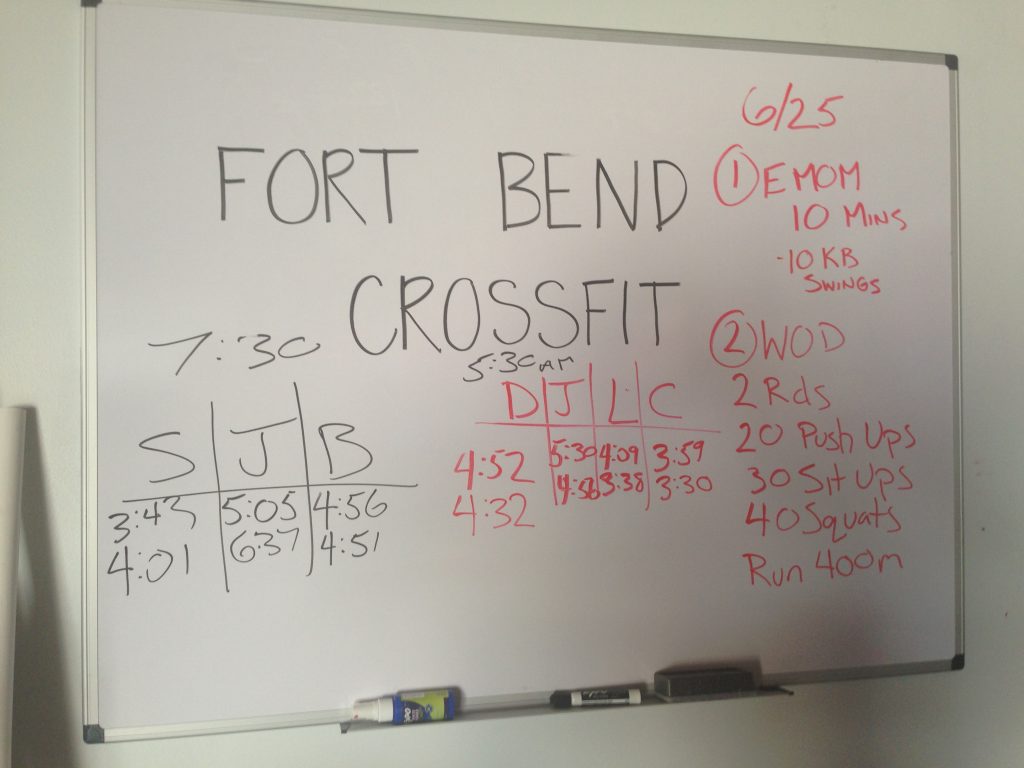

I can honestly say that because being physically active is so ingrained in me and has become a part of my identity, I feel like I’ll always be someone who continues to exercise. It has been the final nail that has cemented exercise as a lifelong habit for myself.
Over time, anyone can reach that point.
Cautions on Identity
I feel like there are some potential downsides of OVERIDENTIFYING as an exerciser. Like anything, too much can be detrimental. If exercise were the only thing I identified as it would negatively impact other areas of my life. And at times, it has.
There have been times where life got in the way and I knew I was going to miss a workout and it stressed me out and caused me great anxiety. I would get in a bad mood and those around me would notice. I learned that that is not healthy!
While I identify as someone who is physically active and strong, I’ve reached a healthy place where I know where it ranks among my other identities/priorities. It has its place and is prioritized correctly. My family, friends, mental well-being, etc. all place higher in regards to their importance to me.
The point of movement is to enhance the quality of our life. It’s to make our time on this earth more enjoyable. It’s so we can live better lives. If missing one workout were to cause so much anxiety it put you in a bad mood, then it would not be serving it’s true purpose. In fact, it would be counter to the very thing it was supposed to accomplish.
I also have felt like for me, it’s important not to identify with too specific of a type of workout. You’ll notice I say I identify as someone who is physically active. Someone who is a mover.
Even though I love CrossFit and lifting weights I don’t say “I’m a crossfitter” or “I’m a weightlifter.” I feel like if I were to do that it would narrow my focus too much and I might miss out on other great physical endeavors.
I want to keep an open mind so I don’t get too attached to any one exercise philosophy.
It’s the same with eating for me. I’ve done Paleo, Keto, etc. But I don’t identify as any of those. I do identify as someone who likes to eat nutritious food. Food that makes me feel good both because it tastes great and also because it fuels me in a positive way. But I don’t identify as keto or paleo or any other type of diet.
Conclusion
I always remind myself to trust the process. The process for me living my best life includes, among many other things, being physically active and exercising. So I’ve done my best over the years to make it a habit.
I know for many maintaining a consistent exercise routine is extremely difficult. I feel this same pain in many other areas of my life. I look at others who are locked in in areas I am not and think to myself how I wish I was on their level.
But when it comes to exercise, I can confidently say it is an entrenched part of my life. It is a habit that is on auto pilot. I don’t think about it, I just do it.
And the steps above are what made exercise a habit for me. And I’m sure they could get you there too!
If you have any specific questions, feel free to reach out to me at james@afitnesspractitioner.com.






